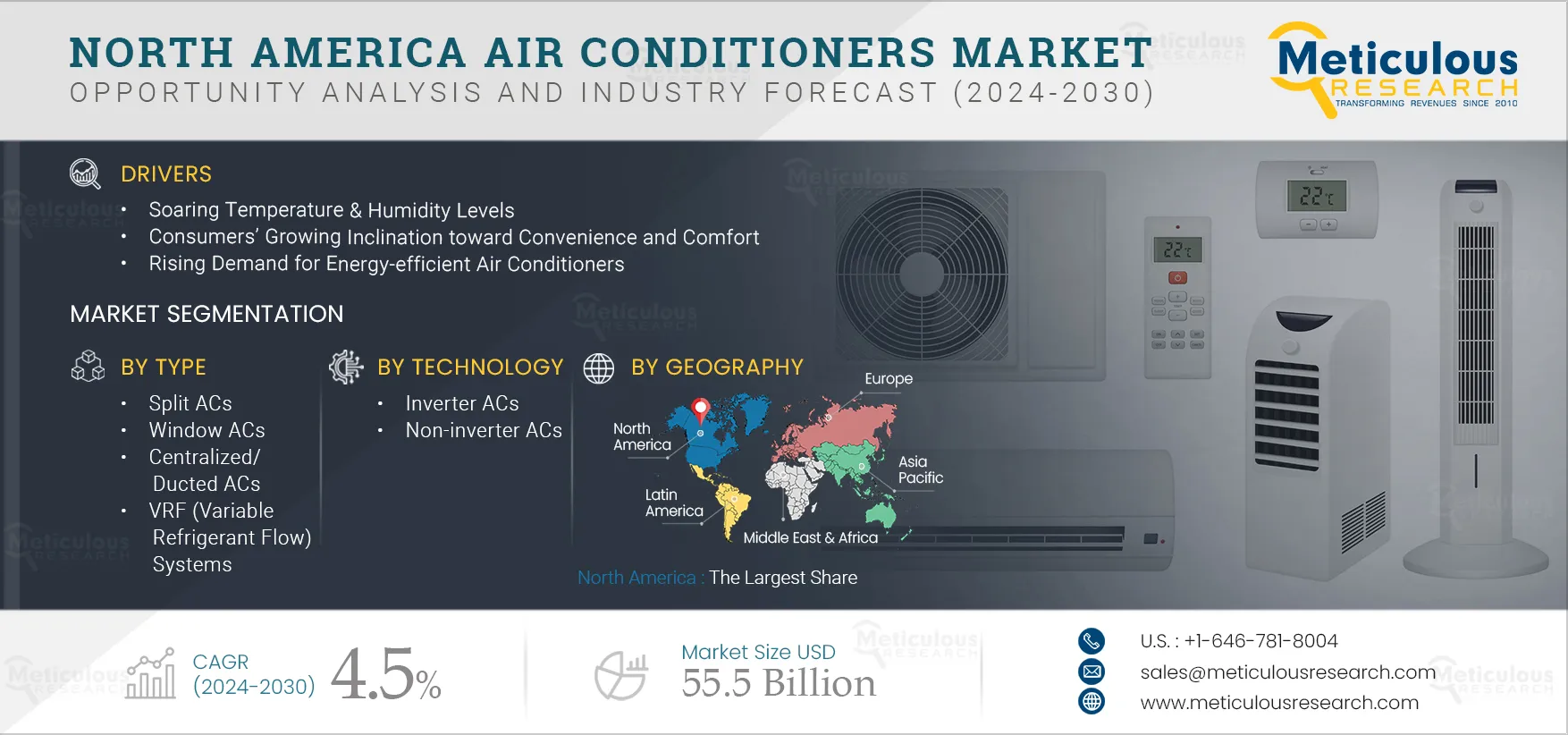The North America Air Conditioners Market is projected to reach $55.5 billion by 2030, at a CAGR of 4.5% during the forecast period 2024–2030. The growth of the North America air conditioners market is attributed to the increasing temperatures and humidity levels, the growing consumer preference for convenience and comfort, and the rising demand for energy-efficient air conditioning systems. However, the high costs of air conditioners restrain the market’s growth.
The rising adoption of air conditioners with inverter and air purification technologies and technological advances in HVAC systems are creating growth opportunities for the players operating in this market. However, the high energy consumption associated with air conditioners poses a challenge to the market’s growth. Moreover, connected air conditioners and the emergence of solar photovoltaic (PV) and solar thermal-assisted air conditioning systems are notable trends in this market.

Click here to: Get Free Sample Pages of this Report
Consumers’ Growing Inclination toward Convenience & Comfort Driving the North America Air Conditioners Market
Air conditioners provide comfort and convenience and reduce fatigue by offering users control over ambient temperature and humidity. Air conditioners also help improve indoor air quality and enable users to sleep better, resulting in overall well-being. They reduce exhaustion in work settings, thereby increasing productivity. As technology advances and lifestyles evolve, people increasingly seek air conditioning solutions that offer enhanced convenience, energy efficiency, and personalized comfort. Smart technology has revolutionized the way people interact with their air conditioning systems. Smart air conditioners can be controlled remotely through smartphone apps, allowing users to adjust settings, monitor energy consumption, and schedule cooling based on their preferences. Integration with virtual assistants like Amazon Alexa or Google Assistant also enables voice control for added convenience.
Modern air conditioners often come equipped with advanced thermostats that allow users to set precise temperature levels for different zones or rooms. This level of customization ensures that occupants can create comfortable environments tailored to their preferences. Consumers are becoming more aware of indoor air quality and its impact on health. Air conditioners equipped with advanced filtration systems, such as HEPA filters, can help remove allergens, dust, and pollutants from the air, providing a healthier indoor environment. As smart homes gain prominence, consumers seek air conditioning systems that seamlessly integrate with their overall home automation setup. This includes compatibility with other smart devices like lighting, security systems, and blinds, enabling centralized control through a single platform.
Key Findings in the North America Air Conditioners Market Study:
The Split ACs Segment to Dominate the North America Air Conditioners Market in 2024
Based on type, the North America air conditioners market is segmented into window ACs, split ACs, VRF (Variable Refrigerant Flow) systems, centralized/ducted ACs, and other air conditioner types. In 2024, the split ACs segment is expected to account for the largest share of the North America air conditioners market. Split AC systems are more energy efficient, use less energy, and keep indoor environments clean. The large market share of this segment is attributed to the increasing demand for energy-saving and low-noise air conditioners and major companies’ rising emphasis on providing quality air conditioners and launching a wide range of split ACs in the market.
The Inverter ACs Segment to Account for the Largest Market Share in 2024
Based on technology, the North America air conditioners market is segmented into inverter ACs and non-inverter ACs. In 2024, the inverter ACs segment is expected to account for the larger share of the North America air conditioners market. The large market share of this segment is attributed to advancements in inverter technology and AC manufacturers’ strong focus on product development and enhancement of inverter-powered ACs.
The Residential End Users Segment to Dominate the North America Air Conditioners Market in 2024
Based on end user, the North America air conditioners market is segmented into residential end users, commercial end users, and industrial end users. In 2024, the residential end users segment is expected to account for the largest share of the North America air conditioners market. The large market share of this segment is mainly attributed to the growing acceptance of smart home technologies, construction companies’ increased focus on offering air-conditioned apartments, and the rising need to improve indoor air quality. Moreover, the residential end users segment is also projected to register the highest CAGR during the forecast period.
Based on geography, the North America air conditioners market is segmented into Indonesia, Thailand, Malaysia, Singapore, Vietnam, and the Rest of North America. In 2024, Indonesia is expected to account for the largest share of the North America air conditioners market. The growing demand for air conditioners among the country’s middle-income population, independent households, the public and hospitality sectors, and the increasing production of air conditioners in the U.S. contribute to the country’s large market share. Further, the growing demand for air conditioners from residential and commercial users, better consumer awareness about air conditioners in the U.S., and growing emphasis by leading U.S.-based players to launch air conditioning products are driving the growth of the air conditioners market in the U.S. Moreover, the market in the U.S is projected to register the highest CAGR during the forecast period.
Key Players:
Some of the key players operating in the North America air conditioners market are Daikin Industries, Ltd. (Japan), Mitsubishi Electric Corporation (Japan), Hitachi-Johnson Controls Air Conditioning (Japan), Carrier Global Corporation (U.S.), Whirlpool Corporation (U.S.), Haier Smart Home Co. Ltd. (China), LG Electronics (South Korea), Panasonic Corporation (Japan), Robert Bosch GmbH (Germany), Samsung Electronics Co., Ltd. (South Korea), Fujitsu Limited (Japan), Blue Star Ltd (India), Toshiba Corporation (Japan), Gree Electric Appliances Inc. (China), and Midea Group Co. Ltd (China).
Scope of the Report:
North America Air Conditioners Market Assessment, by Type
- Split ACs
- Window ACs
- Centralized/Ducted ACs
- VRF (Variable Refrigerant Flow) Systems
- Portable ACs
North America Air Conditioners Market Assessment, by Tonnage
- Up to 2 Tons
- 2 Tons to 5 Tons
- 5 Tons to 10 Tons
- More than 10 Tons
North America Air Conditioners Market Assessment, by Technology
- Inverter ACs
- Non-inverter ACs
North America Air Conditioners Market Assessment, by Rating
- 1 Star ACs
- 2 Star ACs
- 3 Star ACs
- 4 Star ACs
- 5 Star ACs
North America Air Conditioners Market Assessment, by Geography
Key Questions Answered in the Report:
